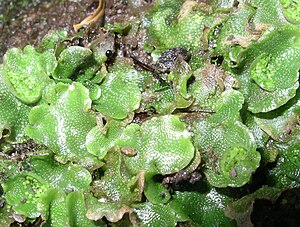Moon cup moss
| Moon cup moss | ||||||||||||
|---|---|---|---|---|---|---|---|---|---|---|---|---|

Moon cup moss ( Lunularia cruciata ) |
||||||||||||
| Systematics | ||||||||||||
|
||||||||||||
| Scientific name of the order | ||||||||||||
| Lunular | ||||||||||||
| DGLong | ||||||||||||
| Scientific name of the family | ||||||||||||
| Lunulariaceae | ||||||||||||
| H.Klinggr. | ||||||||||||
| Scientific name of the genus | ||||||||||||
| Lunularia | ||||||||||||
| Adans. | ||||||||||||
| Scientific name of the species | ||||||||||||
| Lunularia cruciata | ||||||||||||
| (L.) Lindb. |
The Mondbechermoos ( Lunularia cruciata ) is a liverwort and the only representative of the order of the Lunulariales . The moss is actually at home almost worldwide in warm temperate regions, but is now a neophyte in Germany .
The plant has long been part of the Marchantiales , but has been considered a separate order since molecular studies.
features
The moon cup moss forms light green, weakly shiny thalli on both sides , which are about 5 cm long and 1 cm wide. It often grows in extensive blankets and is attached to the substrate. The thallus has simple, volcano-shaped respiratory pores, which can be mixed with oil body cells. There are also delicate, light-colored belly scales. The crescent-shaped breeding cups, which gave the moss its name, are particularly characteristic. They contain numerous brood bodies with which the moss can vegetatively multiply.
Occurrence
The Mondbechermoos has a worldwide distribution in the warm temperature areas. It grows in alkaline, moist, calcareous, nutrient-rich, often frost-protected locations and colonizes both soil and rock (e.g. it is not uncommon on walls). However, it is also common along streams and rivers, in greenhouses, gardens and parks. It was probably introduced from the Mediterranean region in the 19th century and is now naturalized in almost all of Germany. In the meantime, some frost-resistant types have even developed.
neophyte
In Germany it is considered a neophyte. At the beginning of the 19th century it was brought in with potted plants through greenhouses in Germany and was observed by Alexander Braun in the Karlsruhe Botanical Garden in 1828 . In Germany, however, only female plants have been spotted so far. Liverwort reproduces mainly vegetatively through the formation of brood bodies, which are formed in crescent-shaped breeding cups at the end of the thalli. Sexual reproduction, on the other hand, is preferred in the Mediterranean area, where moss is native.
literature
- Aichele / Schwegler: Our moss and fern plants (10th edition, 1993, Kosmos-Verlag) ISBN 3-440-06700-9
- Ruprecht Düll: Excursion pocket book of the Moose (4th edition, IDH-Verlag, 1993)
- Frahm / Frey: Moosflora 4th edition (UTB Verlag), ISBN 3-8252-1250-5
- Georg Schoepe: Lunulariaceae - Mondbechermoose . In: Martin Nebel, Georg Philippi (Hrsg.): Die Moose Baden-Württembergs . tape 3 . Eugen Ulmer, Stuttgart 2005, ISBN 978-3-8001-3278-2 , pp. 105-107 .
Individual evidence
- ↑ Wolfgang Frey, Eberhard Fischer, Michael Stech: Bryophytes and seedless Vascular Plants . In: Wolfgang Frey (Ed.): Syllabus of Plant Families - A. Engler's Syllabus of Plant Families . 13th edition. tape 3 . Borntraeger, Berlin / Stuttgart 2009, ISBN 978-3-443-01063-8 , pp. 29 .
